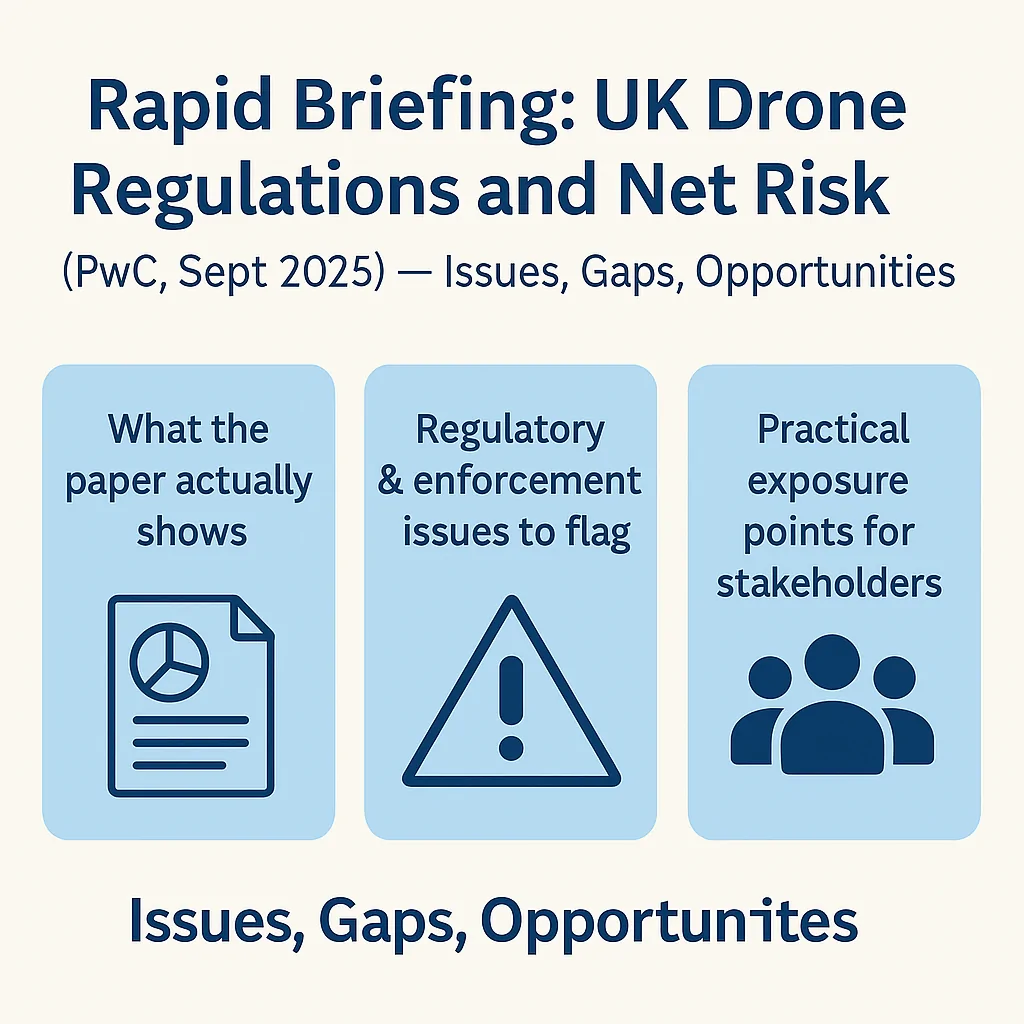What the paper actually shows (evidence you can cite)
- Insurers say risk is intrinsically low; very few third-party injury claims; risk has reduced over the decade with better tech/training. (pp. 9–11)
- UK’s ‘zero-risk + case-by-case’ stance hasn’t produced safer skies than more prescriptive/permissive regimes (US/EU/Canada/Singapore); it has delayed progress. (pp. 12–13)
- Net-risk lens: drones remove more risk than they introduce (e.g., falls from height, confined spaces, helicopter exposure). (pp. 14–18)
- BVLOS doesn’t materially increase risk where well-managed; biggest predictors are location and safety management. (pp. 10–11, 19–22)
- Incident data 2022–24: commercial operations show zero fatalities across UK, US, EU, Canada, Singapore; only a handful of serious injuries. (Appendix + country sections, pp. 55–61)
- SORA friction/cost: UK SORA application at SAIL II is £3,495; mitigations/AMC still qualitative ? “OSC-style” uncertainty persists. (p. 35)
- “Picking winners”: five BVLOS priorities (emergency response, powerlines, maritime SAR, rail, crop spraying). (pp. 6, 25–33)
- Policy levers: shift to digital PDRAs for repeatable, low-risk scenarios; reuse prior approvals; model on EU PDRAs/Canada’s lower-risk BVLOS. (pp. 36–37; Appendix 1)
- Emergency services gap: the old standing exemption (E4506) lapsed; routine BVLOS now hard to get—BTP resorted to State Aircraft rules. (p. 27)
- Comparative table (risk models, UTM status, Remote ID, scale-up reality) explains why the UK feels “high-friction”. (p. 52)
Regulatory & enforcement issues to flag (and build matters around)
- Incoherent risk calibration: the UK treats many Specific-category ops as high-risk despite cross-market low incident severity and strong insurer data. (pp. 9–13, 55–57)
- Process opacity & cost-burden: SORA mitigations/AMC are qualitative ? inconsistent asks; high fees despite narrow temporal/spatial grants. (p. 35)
- Emergency-services capability gap: loss of E4506 creates avoidable delay/risk; forces work-arounds (State Aircraft) rather than transparent PDRA. (p. 27)
- AAE not yet a permissioning tool: policy concept ? scalable authorisation path (contrast EU PDRA-G03 for linear infrastructure). (pp. 28–31, 36)
- Net-risk inversions: requirements like “observer in a boat” for coastal EVLOS can increase system risk and cost vs. sensor-driven shore control. (p. 21)
- Data transparency: the UK has many “record-only” entries; EU public access is patchy; hard for operators/insurers to benchmark safety cases publicly. (pp. 54–61)
Practical exposure points for stakeholders
- Insurers: common declinature trip-wires—ops outside the authorisation envelope; poor log preservation; weak maintenance/firmware governance. (pp. 9–11, 35–36)
- Operators/pilots: SORA drift, local land-use limitations, and fragmented permissions across linear corridors; evidence-pack discipline needed. (pp. 28–31, 35–36, 56–57)
- Associations/community: need bilingual templates/FAQs and incident learning loops; emphasise the airspace vs land-use distinction to reduce friction. (inferred)
- Public bodies (blue-light, MCA, NR, utilities): proven benefits blocked by bespoke approvals—strong case for sector PDRA playbooks. (pp. 26–33, 36)
What this means for drone pilots, operators, and companies
As a drone lawyer, my reading of the PwC paper is that the safety record increasingly supports predictable, rules-based authorisations, but the UK still applies bespoke processes that create delay, cost and legal uncertainty. The winners will be those who treat compliance as an operational capability, not a paperwork chore.
Implications for Drone Pilots
- Documentation is defence: retain native telemetry, app/controller logs, and pre-flight risk assessments. These are crucial in insurer claims and any CAA inquiry.
- VLOS/BVLOS discipline: be explicit about how VLOS was maintained (or the BVLOS mitigations used). Ambiguity here is a common enforcement and insurance pain point.
- Privacy on site: where people are identifiable, prepare a simple lawful-basis note and signage plan; it reduces complaint/escalation risk significantly.
Implications for Operators
- Align your OA/ops manual with SORA and AAE logic: show how mitigations reduce both air and ground risk. Clear mapping cuts questions and accelerates approvals.
- Design for repeatability: build PDRA-ready evidence packs for your most common jobs (e.g., rail/powerline corridors) so each new mission is a variation, not a reinvention.
- Insurance resilience: standardise maintenance/firmware baselines and battery care logs; many declinatures stem from gaps here, not from the incident itself.
- Contracts that reflect reality: flowing down responsibilities to subcontractors (airworthiness, data protection, incident reporting) reduces exposure and smooths procurement.
Implications for Drone Companies & Enterprise Users
- Board-level accountability: appoint a named senior responsible owner (SRO) for UAS operations with decision logs—critical if decisions are later examined in court or by regulators.
- Data governance as an asset: implement DPIAs where warranted, role-based access to imagery, retention/deletion schedules, and breach protocols. This increases tender scores and reduces enforcement risk.
- Public value narrative: quantify how drone tasks remove traditional risks (work at height, road possessions, helicopter hours). This “net-risk” case supports proportional, scalable permissions.
Where legal support helps, assists, and mitigates
- Approvals & permissions: structuring SORA/AAE applications with proportional mitigations, re-using prior evidence, and narrowing scope to reduce fees and conditions.
- Policy & appeals: challenging irrational or net-risk-increasing conditions; seeking clarifications; and preparing proportionate alternatives that the regulator can accept.
- Privacy & data: lawful-basis memos, DPIAs, signage/LLN templates, and response playbooks for complaints or subject access requests.
- Insurance & claims: coverage mapping, notification strategy, and evidence preservation to avoid declinature; subrogation prospects where third parties contributed to loss.
- Contracts: allocating risk cleanly across clients, operators and subcontractors (indemnities, limitation, IP/data ownership, incident reporting).
Bottom line: the sector is safe and maturing. Those who can demonstrate their risk controls, evidence compliance, and standardise approvals will grow fastest—with fewer legal shocks along the way.
Talking points for meetings & panels
- Same safety, slower UK growth: insurers and incident data show low intrinsic risk—authorisations should be predictable and prescriptive, not bespoke. (pp. 9–13, 36–37)
- Digital PDRAs now: for repeatable BVLOS (powerlines/rail/SAR/maritime/agri)—reuse evidence from prior OSCs; mirror EU PDRA/Canada logic. (pp. 25–33, 36)
- Emergency drones need an emergency rulebook: the E4506 gap is pushing forces into State Aircraft work-arounds. (p. 27)
- Incident reality: zero fatalities in 2022–24 across major markets; claims are mainly minor property/equipment—calibrate conditions accordingly. (pp. 55–61; pp. 9–11)


 “`By Richard Ryan, barrister and drone lawyer
“`By Richard Ryan, barrister and drone lawyer